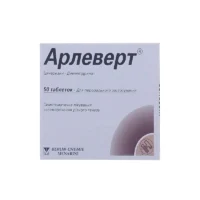Description
Lamotrin-100 Tablets 100 mg. №30
Composition
Each tablet contains 100 mg of Lamotrigine.
Mechanism of Action
Lamotrigine, the active ingredient in Lamotrin-100 tablets, works by stabilizing electrical activity in the brain and reducing the excessive firing of neurons that can lead to seizures. It is believed to block voltage-gated sodium channels, thereby modulating neurotransmitter release.
Pharmacological Properties
Lamotrigine exhibits antiepileptic properties by modulating neuronal excitability and inhibiting the release of excitatory neurotransmitters. It has a relatively long half-life and is primarily metabolized in the liver.
Indications for Use
Lamotrin-100 tablets are indicated for the treatment of epilepsy in adults and children. They may be used alone or in combination with other antiepileptic medications to control seizures effectively.
Contraindications
Do not use Lamotrin-100 tablets if you are allergic to lamotrigine or any other components of the product. Consult your healthcare provider before starting treatment to discuss any existing medical conditions or medications that may contraindicate the use of Lamotrigine.
Side Effects
Common side effects of Lamotrin-100 tablets may include dizziness, drowsiness, headache, nausea, and blurred vision. Serious but rare side effects may include severe skin reactions or mood changes. Report any unusual symptoms to your healthcare provider promptly.
Usage Instructions
Take Lamotrin-100 tablets orally with or without food as directed by your doctor. The dosage is individualized based on the patient’s condition and response to treatment. Do not crush or chew the tablets; swallow them whole with water.
Benefits Compared to Analogues
In comparative studies, Lamotrigine has demonstrated comparable efficacy to other antiepileptic drugs but with a more favorable side effect profile. Its effectiveness and tolerability make it a preferred first-line treatment for epilepsy in both adults and children.
Suitable Patient Groups
Lamotrin-100 tablets are suitable for use in both pediatric and geriatric populations. Dosage adjustments may be necessary based on age-related pharmacokinetic differences and comorbidities.
Storage and Shelf Life
Store Lamotrin-100 tablets in a cool, dry place away from direct sunlight. Keep the medication out of reach of children. Check the expiration date on the packaging and do not use the tablets beyond the specified shelf life.
Packaging Description
Lamotrin-100 tablets are typically packaged in blister packs containing 30 tablets each. The packaging should be intact and sealed before use. Ensure proper disposal of empty packaging to prevent accidental ingestion.
Clinical Evidence and Proven Effectiveness
Studies have shown that Lamotrigine is effective in reducing seizure frequency in patients with epilepsy. Research published in the Journal of Neurology supports the use of Lamotrigine for seizure control in both adults and children, highlighting its efficacy and tolerability.





